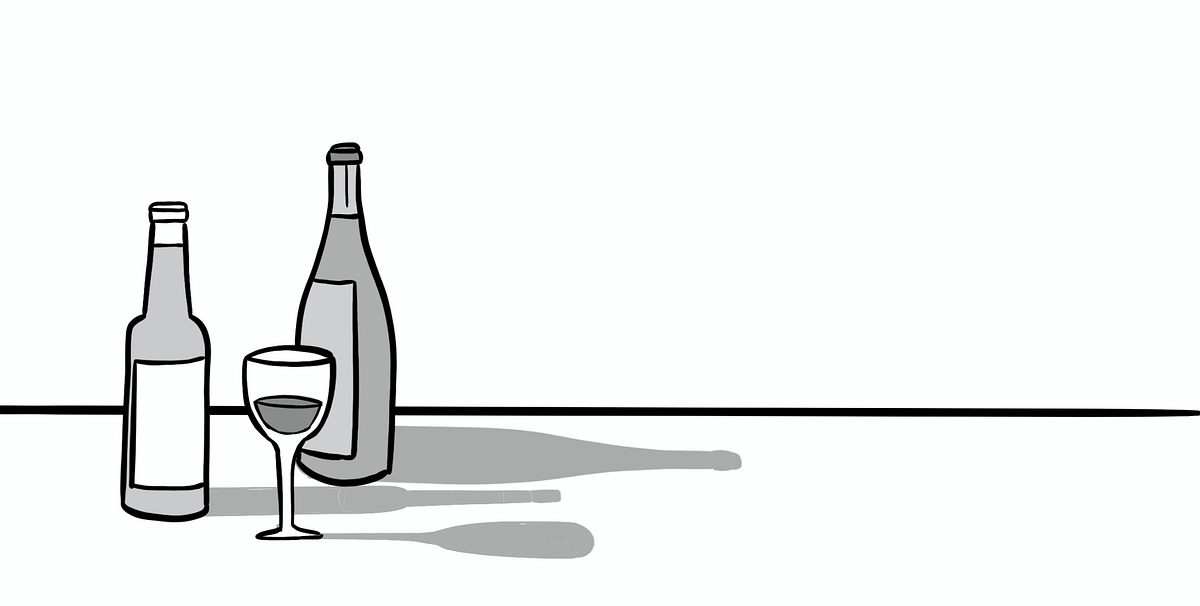Compassion / No Malice
Humans have been writing for 5,000 years and drinking for even longer. Archaeologists recently discovered 13,000-year-old beer in a cave near modern Haifa, Israel, and archaeological evidence of alcohol consumption exists worldwide dating back to 5,000 BC. The allure of alcohol is a cocktail of biology, psychology, and social norms. Above all, it illuminates the brain's dopamine reward system. For most of history, it was safer to drink fermented things than water. If TikTok had existed before Christ, it would have influenced physical fitness. We have integrated firewater into the longest-lasting rituals throughout modern times. Humanity has a deep-rooted relationship with fermentation.
However, this data suggests that Western culture is structurally shifting away from alcohol as entertainment, social lubricant, self-medication, or ritual. Everyone except the alcohol industry views this as a positive development, as alcohol is the third leading cause of death in the U.S. and a risk factor for early mortality among youth. But the relationship with alcohol itself is not so simple.
Half
Between 2002 and 2018, the percentage of college students who do not drink increased from 20% to 28%, and overall, Gen Z drinks 20% less per capita than Millennials did at the same age, and 20% less than Gen X. Among high school students, 39% reported drinking alcohol in 2011. Today, only 23% do. The number of high school students who drink has nearly halved in a decade. Despite another widespread change, youth drinking is declining. Gender differences are narrowing. Older cohorts are drinking more. Women from generations that grew up drinking are now more accepted as they age. The trend is global. In Japan, where the culture of drinking is rooted in establishing trust, 60% of the population now believes that drinking after work is no longer necessary. Teen drinking in the UK has been declining for 20 years.
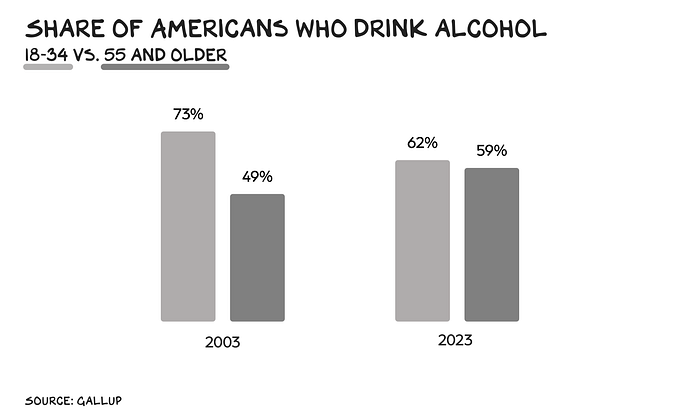
While youth experiences like mixtapes or phone waiting have not eliminated drinking, the cultural influence of shifts is greater than the numbers suggest. Concert promoters have reported dramatic reductions in alcohol sales at shows with young audiences, and concessions are starting to offer more alcohol options. Alcohol giant AB Inbev's Project NO/LOW brands (non-alcoholic versions of traditionally alcoholic beverages) are expected to account for 20% of sales by 2025. Premium mocktails and dry bars participate in Dry January every January.
Toxicity
This generation's caution around alcohol is not unfounded. It can be toxic. It can destroy lives or the lives of others long before the liver is damaged or cancer is induced. 30 million Americans maintain clinically unsafe relationships with alcohol, and in addition to killing over 80,000 people each year through chronic diseases, alcohol also leads to nearly 60,000 acute deaths (from drunk driving, overdoses, and suicides). And when I was in high school in Los Angeles, it felt like there were monthly photos and flowers for a kid who died in a drunk driving accident.
Our understanding of the dangers of alcohol has evolved recently. For millennia, we have known alcohol to be a serious negative. Plato believed in a drinking age of 18. However, we primarily worried about excessive drinking and dependency, avoiding the recognized overreach. Moderation was considered harmless and even beneficial. Morris Chafetz, the first director of the National Institute on Alcohol Abuse and Alcoholism, wrote a book advocating for alcohol addiction as a medical issue rather than a moral one, stating it “causes permanent direct damage to the body.”
Dr. Chafetz was wrong. We now know that even light drinking can increase cancer risk. Alcohol is classified as a Group 1 carcinogen, the highest risk group, which includes asbestos and tobacco. Research in Europe indicates that half of all cancers attributed to alcohol arise from light or moderate drinking. It’s not just cancer risk: moderate drinking reduces brain volume. Older studies have reassessed the health benefits of light drinking, and their conclusions raised serious doubts. In 2022, the World Heart Federation stated: “Contrary to popular belief, alcohol is not good for the heart.” And in January 2023, the World Health Organization stated that researchers have known for years that “levels of alcohol consumption are not safe for health.”
Today's youth do not need to read scientific journals to keep up with the latest science regarding alcohol, as social media is a hot topic. TikToks and Reels about the risks and downsides of drinking are a genre, and skits about "hang-xiety" have recently been a hit on SNL. Alcohol companies spend nearly $2 billion annually on advertising featuring the most attractive people in society and high production values. However, in society, the cool Swedish doctor can reach millions with the cool news that women are six times more likely than men to develop cirrhosis with equal alcohol consumption (adjusted for weight). The cool doctor with a beard can reach even more people. Social media has many harms, and drinking is not a small one (Google #borg for more on #borg).
Despite experiences at the Summit at Sea, moving away from alcohol does not seem to be a replacement of one chemical for another. Marijuana use (not freely burning health) is increasing as legalization allows weed to enter the mainstream. Party drugs or hallucinogens used for creativity or productivity are experiencing a revival. However, these increases are dwarfed by the overall decrease in substance consumption. Marijuana use among teens has actually declined over the past decade, and opioid abuse has plateaued.
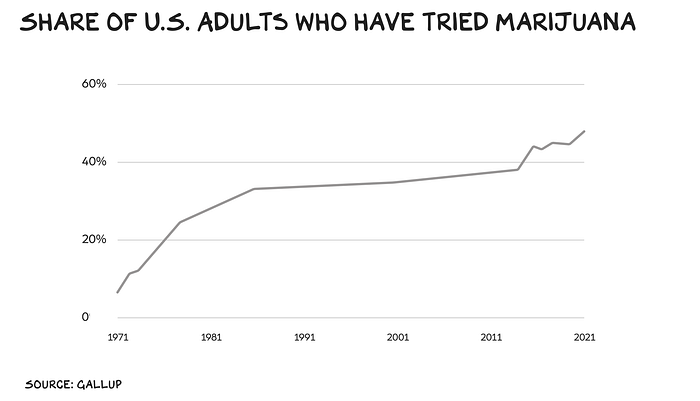
More is at play. The science of alcohol harm is the science of statistics: probabilities and long-term chances. Generally, it has not won the argument against the energy of youth. Why is this generation suited for abstinence?
No/Low… Risks
The only vice that young people are leaving behind is drinking. Risky behaviors are declining overall. Young people are much less likely to drive. Between 1995 and 2021, the percentage of licensed teens dropped from 64% to below 40% decreased. As someone who got my license on my 16th birthday and spent 200% of my disposable income on a 1980 Renault Le Car, this seems crazy to me. Additionally, young people are having less sex. In 2011, 47% of high school students reported having sex. By 2021, that number had dropped to 30%. Note: (UN) related news lost virginity at 19. (See above: Renault Le Car. Before accessing a Discovery card or Android phone, I found equally strong prevention: a French lawn with a door that screamed “I don’t know this person.”) Similar declines have been observed in other sexual behavior measures, such as partner count. Lawbreaking has decreased since the mid-90s, and the rate of decline has accelerated since 2010.
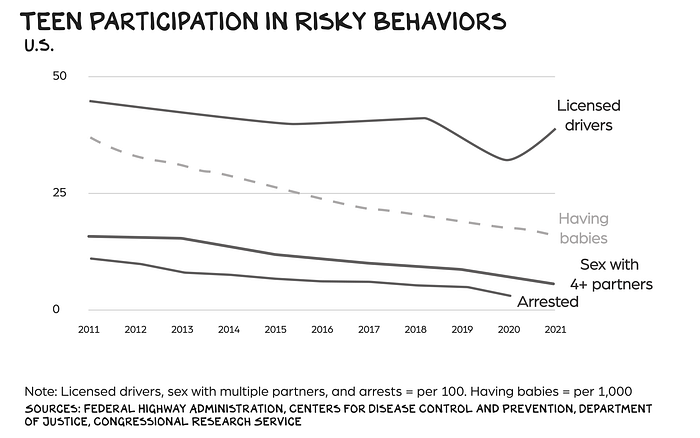
However, young people are engaging in increasingly risky behaviors regarding suicide. Between 2007 and 2021, the suicide rate among Americans aged 10 to 24 rose from 6.8 (per 100k) to 11 increased.
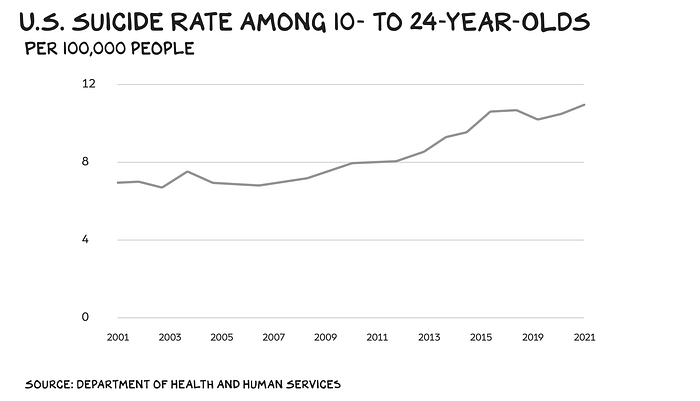
This is the tragic tip of the iceberg that Jonathan Haidt predicted a decade ago regarding the teen mental health crisis. Since 2011, the percentage of high school students reporting “persistent sadness or hopelessness” has increased from 28% to 42% increased. Recent research on rising suicide rates indicates that “the increase in depression prevalence among young people in the 2010s can explain nearly all of the increase in suicide mortality among those under 25.” Pause. If 50% of our kids feel hopeless, what the hell is the point of “this”?
Gen Z explains why they feel so bad. They face anxiety on all fronts. Their careers will be performances on Zoom calls with low wages and no healthcare. They struggle to pay student loans, buy homes, or have children. Dating and sexual dynamics have become increasingly risky unless there are obvious allegations. More than one-third of Gen Z identifies climate change as their single biggest concern. And always in the background is the knowledge that their lives are permanently and publicly recorded. 49% of Gen Zers say that their online image is on their mind when socializing or drinking.
Trying to write all this down about teen anger and young adult struggles is a fear that did not exist 30 years ago. How did you handle this? Were you a model of thoughtful grace at 18?
Snowplow
Ironically, part of the answer is that no generation has ever received more support and protection than this one. We joked about “helicopter parents” hovering over kids, but now we have “snowplow parents” who clear the path for their offspring, smoothing out life’s obstacles. Parents are getting closer to their young children than ever, thanks to technology that tracks every movement .
As a member of Gen X, I would not have spent more than 12 hours watching or listening to Bahne Skateboard, 35¢, and Abba-Zaba bars on a Saturday morning. If my kid is more than 15 minutes late, the Navy SEALs and MI6 are activated. Children’s lives are programmed, pre-planned, and packaged, with 50% less unstructured time than previous generations. The result is lower resilience and increased anxiety. We use so many hygiene wipes in our kids' lives that they do not develop their own immunity.
Once they leave the physical nest (but often tethered electronically), young people respond to a combination of coding and fear in various ways. The rise in anxiety pairs with an obsession with the need for control. “Optimization bros” track every glass of water, “hack” sleep cycles, and push more sophisticated diets and health regimens onto their cohorts. Tech companies facilitate this, embedding all kinds of devices in gadgets and encouraging constant wear. Clearly, there is no room for beer in that schedule.
Seize the Opportunity
Every generation inherits the assets and liabilities of the previous one. However, we are maturing an immature generation that can deal with real challenges and opportunities. Instead, we are protecting them from risks that are real or perceived while exploiting fears about rejection, b-, hangovers, and unknown dangers. My mom worried that I would face too many hardships. Now I worry that my kids won’t get enough.
The decline in youth drinking is not about alcohol. It’s about a generation that fears the consequences of the slightest slip in impulse control. This could be a spark in a world with a permanent gas leak (social media) ready to ignite a shameful storm.
There are many positives to the decline in alcohol consumption. However, it also means a reduction in the historically facilitated rites of passage and communal bonding that alcohol has provided. It has reduced drunken hugs and “I Love Yous,” first dances, first kisses, and first dates. While there are many risks in drinking, it also opens up new experiences. You don’t have to work through substances, but sometimes you need to lower inhibitions.
Better
The stages of my life align with the evolution of my preferred substances. College, beer, and THC; early career, vodka; mid-life, bourbon and rum; less bourbon and rum and more THC. I enjoy alcohol and THC, and I believe I have gained more from them than they have from me. Addiction has been a social and professional tool integrated into my life, like exercise and meals.
I am a slightly better version of myself. A definition of “good” drunk. More fun, more affectionate, and in touch with my emotions. Every romantic partner I’ve had has encouraged me to drink more in various ways. It’s a bug, not a feature. Male sexual sensibility suppresses my ability to express how much friends/colleagues mean to me unless it is inspired by alcohol.
Often, when writing this newsletter, I will tell people how much they mean to me over a drink of Zaca and cola. The next day, after reviewing the text, I feel embarrassed but not regretful. My issue is not that it means something when I’m drunk, but that it doesn’t mean something when I’m sober. Hemingway drank to make others more interesting. I drink to make myself more interesting. If the previous sentence sounds a bit pathetic or like a form of alcoholism, trust your instincts.
Life is too rich and

PS Predictions 2024 are on Tuesday. Don’t miss the chance to hear my predictions for next year. A review of how I did in 2023 .
